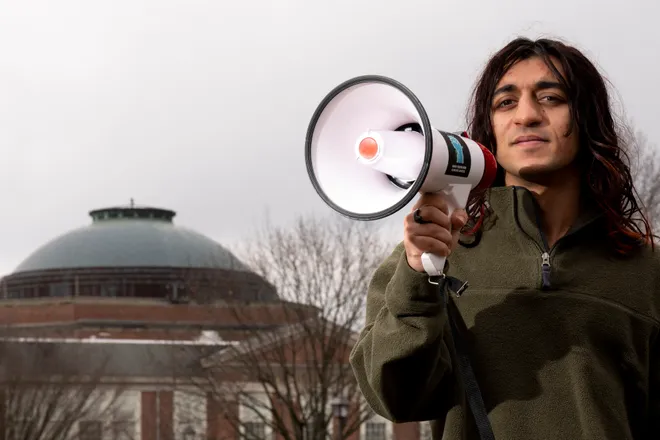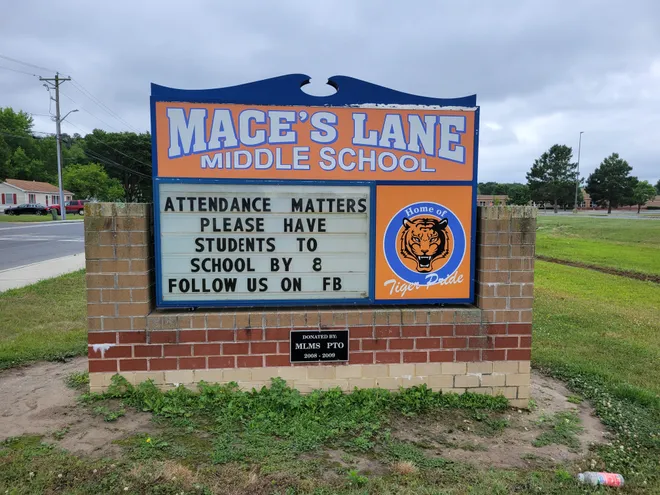Vague school rules at the root of millions of student suspensions

A Rhode Island student smashed a ketchup packet with his fist, splattering an administrator. Another ripped up his school work. The district called it “destruction of school property.” A Washington student turned cartwheels while a PE teacher attempted to give instructions.
A pair of Colorado students slid down a dirt path despite a warning. An Ohio 12th grader refused to work while assigned to the in-school suspension room. Then there was the Maryland sixth grader who swore when his computer shut off and responded “my bad” when his teacher addressed his language.
Their transgressions all ended the same way: The students were suspended.
Discipline records state the justification for their removals: These students were disorderly. Insubordinate. Disruptive. Disobedient. Defiant. Disrespectful.
At most U.S. public schools, students can be suspended, even expelled, for these ambiguous and highly subjective reasons. This type of punishment is pervasive nationwide, leading to hundreds of thousands of missed days of school every year, and is often doled out for misbehavior that doesn’t seriously hurt anyone or threaten school safety, a Hechinger Report investigation found.
Districts cited one of these vague violations as a reason for suspending or expelling students more than 2.8 million times from 2017-18 to 2021-22 across the 20 states that collect this data. That amounted to nearly a third of all punishments recorded by those states. Black students and students with disabilities were more likely than their peers to be disciplined for these reasons.
Because categories like defiance and disorderly conduct are often defined broadly at the state level, teachers and administrators have wide latitude in interpreting them, according to interviews with dozens of researchers, educators, lawyers and discipline reform advocates. That opens the door to suspensions for low-level infractions.
“Those are citations you can drive a truck through,” said Jennifer Wood, executive director for the Rhode Island Center for Justice.
The Hechinger Report also obtained more than 7,000 discipline records from a dozen school districts across eight states through public records requests. They show a wide range of behavior that led to suspensions for things like disruptive conduct and insubordination. Much of the conduct posed little threat to safety. For instance, students were regularly suspended for being tardy, using a phone during class or swearing.
Teachers need other tools to address behavior
Decades of research have found that students who are suspended from school tend to perform worse academically and drop out at higher rates. Researchers have linked suspensions to lower college enrollment rates and increased involvement with the criminal justice system.
These findings have spurred some policymakers to try to curtail suspensions by limiting their use to severe misbehavior that could harm others. Last year, California banned all suspensions for willful defiance. Other places, including Philadelphia and New York City, have similarly eliminated suspensions for low-level misconduct.
Elsewhere, though, as student behavior has worsened following the pandemic, legislators are calling for stricter discipline policies, concerned for educators who struggle to maintain order and students whose lessons are disrupted. These legislative proposals come despite warnings from experts and even classroom teachers who say more suspensions – particularly for minor, subjective offenses – are not the answer.
Roberto J. Rodríguez, assistant U.S. education secretary, said he was concerned by The Hechinger Report’s findings. “We need more tools in the toolkit for our educators and for our principals to be able to respond to some of the social and emotional needs,” he said. “Suspension and expulsion shouldn’t be the only tool that we pull out when we see behavioral issues.”
In Rhode Island, insubordination was the most common reason for a student to be suspended in the years analyzed. Disorderly conduct was third.
In the Cranston Public Schools, these two categories accounted for half of the Rhode Island district’s suspensions in 2021-22. Disorderly conduct alone made up about 38%.
Behavior that led to a such a suspension there in recent years included:
- Getting a haircut in the bathroom;
- Putting a finger through the middle of another student’s hamburger at lunch;
- Writing swear words in an email exchange with another student;
- Throwing cut up pieces of paper in the air;
- Stabbing a juice bottle with a pencil and getting juice all over a table and peers; and
- Leapfrogging over a peer and “almost” knocking down others.
Cranston school officials did not respond to repeated requests for comment.
Rhode Island Department of Education spokesperson Victor Morente said in an email that the agency could not comment on specific causes for suspension, but that the department “continues to underscore that all options need to be exhausted before schools move to suspension.”
The department defines disorderly conduct as “Any act which substantially disrupts the orderly conduct of a school function, (or) behavior which substantially disrupts the orderly learning environment or poses a threat to the health, safety, and/or welfare of students, staff, or others.”
States let school districts define punishment

Many states use similarly unspecific language in their discipline codes, if they provide any guidance at all, a review of state policies found.
For education departments that do provide definitions to districts, subjectivity is frequently built in. In Louisiana’s state guidance, for instance, “treats authority with disrespect” includes “any act which demonstrates a disregard or interference with authority.”
Ted Beasley, spokesperson for the Louisiana Department of Education, said in an email that discipline codes are not defined in state statutes and that “school discipline is a local school system issue.”
Officials in several other states said the same.
The result, as demonstrated by a review of discipline records from eight states, is a broad interpretation of the categories: Students were suspended for shoving, yelling at peers, throwing objects, and violating dress codes. Some students were suspended for a single infraction; others broke several rules.
In fewer than 15% of cases, students got in trouble for using profanity, according to a Hechinger analysis of the records. The rate was similar for when they yelled at or talked back to administrators. In at least 20% of cases, students refused a direct order and in 6%, they were punished for misusing technology, including being on the cell phones during class or using school computers inappropriately.
“What is defiance to one is not defiance to all, and that becomes confusing, not just for the students, but also the adults,” said Harry Lawson, human and civil rights director for the National Education Association, the country’s largest teachers union. “Those terms that are littered throughout a lot of codes of conduct, depending on the relationship between people, can mean very different things.”
But giving teachers discretion in how to assign discipline isn’t necessarily a problem, said Adam Tyner, national research director at the Thomas B. Fordham Institute. “The whole point of trusting, in this case, teachers, or anyone, to do their job is to be able to let them have responsibility and make some judgment calls,” he said.
Tyner added that it’s important to think about all students when considering school discipline policies. “If a student is disrupting the class, it may not help them all that much to take them and put them in a different environment, but it sure might help the other students who are trying to learn,” he said.
Johanna Lacoe spent years trying to measure exactly that – the effect of discipline reforms on all students In Philadelphia, including those who hadn’t been previously suspended. The district banned out-of-school suspensions for many nonviolent offenses in 2012.
Critics of the policy shift warned that it would harm students who do behave in class; they’d learn less or even come to school less often. Lacoe’s research found that schools faithfully following the new rules saw no decrease in academic achievement or attendance for non-suspended students.
But, the policy wasn’t implemented consistently, the researchers found. The schools that complied already issued the fewest suspensions; it was easier for them to make the policy shift, Lacoe said. In schools that kept suspending students, despite the ban, test scores and student attendance fell slightly.
Overall, though, students who had been previously suspended showed improvements. Lacoe called eliminating out-of-school suspensions for minor infractions a “no brainer.”
“We know suspensions aren’t good for kids,” said Lacoe, the director of the California Policy Lab, a group that partners with government agencies to research the impact of policies. “Kicking kids out of school and providing them no services and no support and then returning them to the environment where nothing has changed is not a good solution.”
Students say suspensions are ineffective
This fall, two high schoolers in Providence, Rhode Island, walked out of a classroom. They later learned they were being suspended for their action, because it was considered disrespectful to a teacher.
“It’s because they don’t like us,” said one of the students, Anaya, whose last name is being withheld to protect her privacy.
In 2021-22, disorderly conduct and insubordination made up a third of all Providence Public School suspensions.
District spokesperson Jay Wegimont said in an email that the district uses many alternatives to suspension, and out-of-school suspensions are only given to respond to “persistent conduct which substantially impedes the ability of other students to learn.”
But nearly all parents and students interviewed for this series who have dealt with suspension for violations such as disrespect and disorderly conduct also said that the punishment often did nothing but leave the student frustrated with the school and damage the student’s relationships with teachers.
From a suspended student to an advocate for others
At a Cincinnati high school in 2019, Yousuf Munir led a peaceful protest about the impact of climate change, with about 50 fellow students. Munir, then a junior, planned to leave school and join a larger protest at City Hall. The principal said Munir couldn’t go and threatened to assign detention.

Munir left anyway.
That detention morphed into suspension for disobeying the principal, said Munir, who remembers thinking: “The only thing you’re doing is literally keeping me out of class.”
The district told The Hechinger Report that Munir was suspended for leaving campus without written permission, a decision in line with the district’s code of conduct.
The whole incident left Munir feeling “so angry I didn’t know what to do with it.” They went on to start the Young Activists Coalition, which advocated for fair discipline and restorative practices at Cincinnati Public Schools.
Now in college, Munir is a mentor to high school kids. “I can’t imagine ever treating a kid that way,” they said.
Searching for consequences beyond suspension
Parents and students around the country described underlying reasons for behavior problems that a suspension would do little to address: Struggles with anxiety. Frustration with not understanding classwork. Distraction by events in their personal lives.
Discipline records are also dotted with examples that indicate a deeper cause for the misbehavior.
In one case, a student in Rhode Island was suspended for talking back to her teachers; the discipline record notes that her mother had recently died and the student might need counseling. A student in Minnesota “lost his cool” after having “his buttons pushed by a couple peers.” He cursed and argued back. A Maryland student who went to the main office to report being harassed cursed at administrators when asked to formally document it.
To be sure, discipline records disclose only part of a school’s response, and many places may simultaneously be working to address root causes. Even as they retain – and exercise – the right to suspend, many districts across the country have adopted alternative strategies aimed at building relationships and repairing harm caused by misconduct.
“There needs to be some kind of consequence for acting out, but 9 out of 10 times, it doesn’t need to be suspension,” said Judy Brown, a social worker in Minneapolis Public Schools.
Some educators who have embraced alternatives say in the long run they’re more effective. Suspension temporarily removes kids; it rarely changes behavior when they return.
“It’s really about having the compassion and the time and patience to be able to have these conversations with students to see what the antecedent of the behavior is,” Brown said. “It’s often not personal; they’re overwhelmed.”
In some cases, students act out because they don’t want to be at school at all and know the quickest escape is misbehavior.
On Valentine's day 2022, a Maryland seventh grader showed up to school late. She then refused to go to class or leave the hallway and, according to her Dorchester County discipline record, was disrespectful towards an educator. "These are the behaviors (the student) typically displays when she does not want to go to class," her record reads.
By 8:30 she was suspended and sent home for three days.
Dorchester County school officials declined to comment. In 2021-22, 38% of suspensions and expulsions in the district were assigned for disrespect and disruption.

This district took a hard look at its discipline practices
Last year, administrators in Minnesota’s Monticello School District spent the summer overhauling their discipline procedures and consequences, out of concern that students of color were being disproportionately disciplined. They developed clearer definitions for violation categories and instituted non-exclusionary tools to deal with isolated minor misbehaviors.
Previously, the district suspended students for telling an “inappropriate joke” in class or cursing, records show. Those types of behavior will now be dealt with in schools, Superintendent Eric Olsen said, but repeated refusals and noncompliance could still lead to a suspension.
“Would I ever want to see a school where we can’t suspend? I would not,” he said. “Life is always about balance.”
Olsen wants his students – all students – to feel valued and be successful. But they’re not his only consideration. “You also have to think of your employees,” he said. “There’s also that fine line of making sure your staff feels safe.”
Monticello, like most school districts across the country, has seen an increase in student misconduct since schools reopened after pandemic closures. A 2023 survey found that more than 40% of educators felt less safe in their schools compared with 2019 and, in some instances, teachers have been injured in violent incidents, including shootings.
And even before 2020, educators nationwide were warning that they lacked the appropriate mental health and social service supports to adequately deal with behavior challenges. Some nonviolent problems, like refusal to put phones away or stay in one’s seat, can make it difficult for teachers to effectively do their jobs.
And the discipline records reviewed by The Hechinger Report do capture a sampling of more severe misbehavior. In some cases, students were labeled defiant or disorderly for fighting, throwing chairs or even hitting a teacher.
Shatara Clark taught for 10 years in Alabama before feeling too disrespected and overextended to keep going. She recalled regular disobedience from students.
“Sometimes I look back like, ‘How did I make it?’” Clark said. “My blood pressure got high and everything.”
She became so familiar with the protocol for discipline referrals that she can still remember every step two years after leaving the classroom. In her schools, students were suspended for major incidents like fighting or threatening a teacher but also for repeated nonviolent behavior like interrupting or speaking out in class.
Clark said discipline records often don’t show the full context. “Say for instance, a boy got suspended for talking out of turn. Well, you're not going to know that he's done that five times, and I've called his parents,” she said. “Then you see someone that's been suspended for fighting, and it looks like the same punishment for a lesser thing.”
In many states, reform advocates and student activists pushing to ban harsh discipline policies have found a receptive audience in lawmakers. Many teachers are also sympathetic to their arguments; the National Education Association and American Federation of Teachers support discipline reform and alternatives to suspension.
In some instances, though, teachers have resisted efforts to curtail suspensions, saying they need to have the option to remove kids from school.
Many experts say the largest hurdle to getting teachers to embrace discipline reforms is that new policies are often rolled out without training or adequate staffing and support.
Without those things, “the policy change is somewhat of a paper tiger,” said Richard Welsh, an associate professor of education and public policy at Vanderbilt University. “If we don’t think about the accompanying support, it’s almost as if some of these are unfunded mandates.”
In Monticello, Olsen has focused on professional development for teachers to promote alternatives to suspension. The district has created space for students to talk about their actions and how they can rebuild relationships.
It’s still a work in progress. Teacher training, Olsen says, is key.
“You can’t just do a policy change and expect everyone to magically do it.”
CONTRIBUTING: Hadley Hitson of the Montgomery Advertiser and Madeline Mitchell of the Cincinnati Enquirer, members of the USA TODAY Network; and Amanda Chen, Tazbia Fatima, Sara Hutchinson, Tara García Mathewson, and Nirvi Shah, The Hechinger Report.
Note: The Hechinger Report'sFazil Khan had nearly completed the data analysis and reporting for this project when he died in a fire in his apartment building. USA TODAY Senior Data Editor Doug Caruso completed data visualizations for this project based on Khan’s work.
This story about classroom discipline was produced by USA TODAY publishing partner The Hechinger Report, a nonprofit, independent news organization focused on inequality and innovation in education.
Disclaimer: The copyright of this article belongs to the original author. Reposting this article is solely for the purpose of information dissemination and does not constitute any investment advice. If there is any infringement, please contact us immediately. We will make corrections or deletions as necessary. Thank you.


